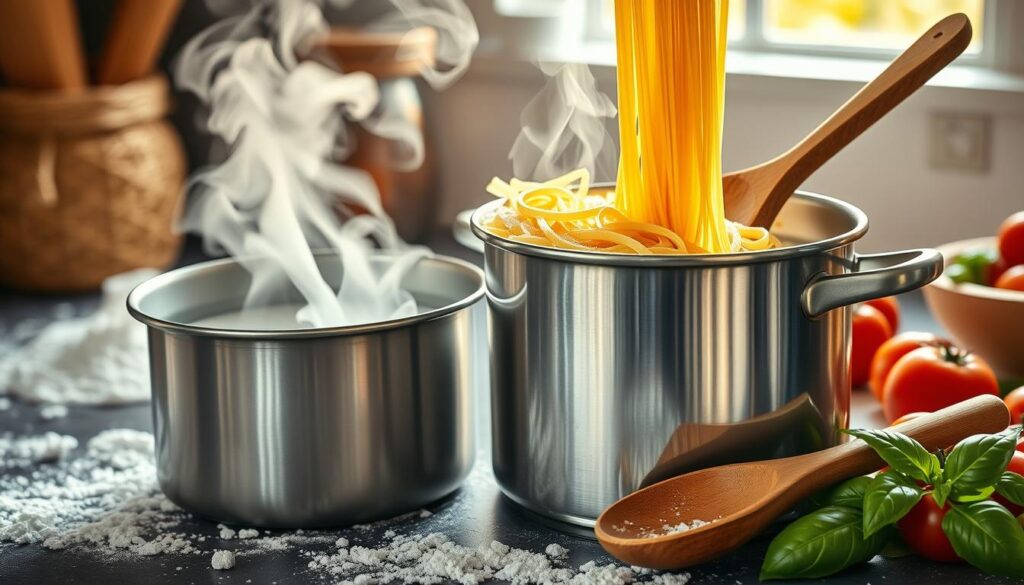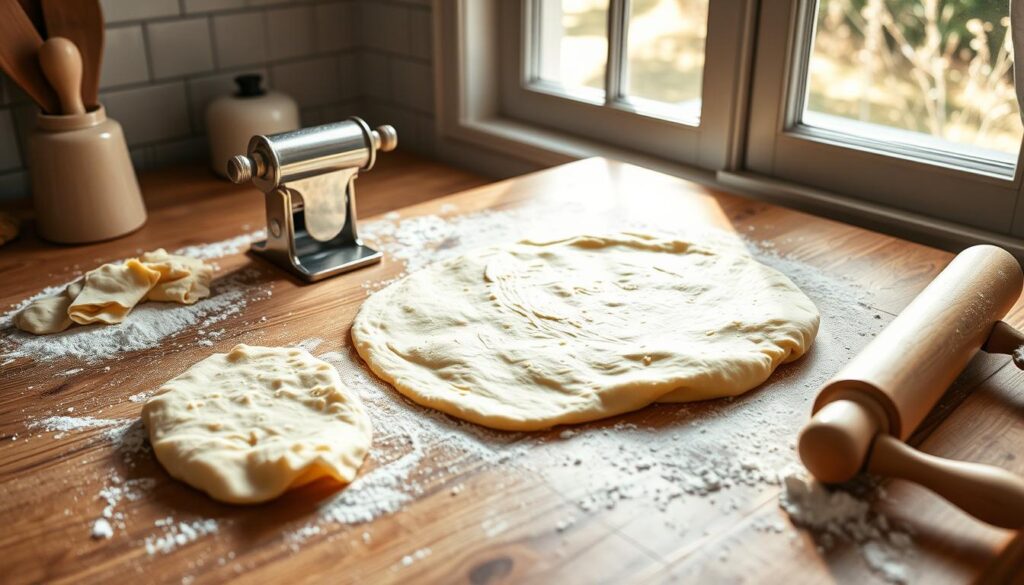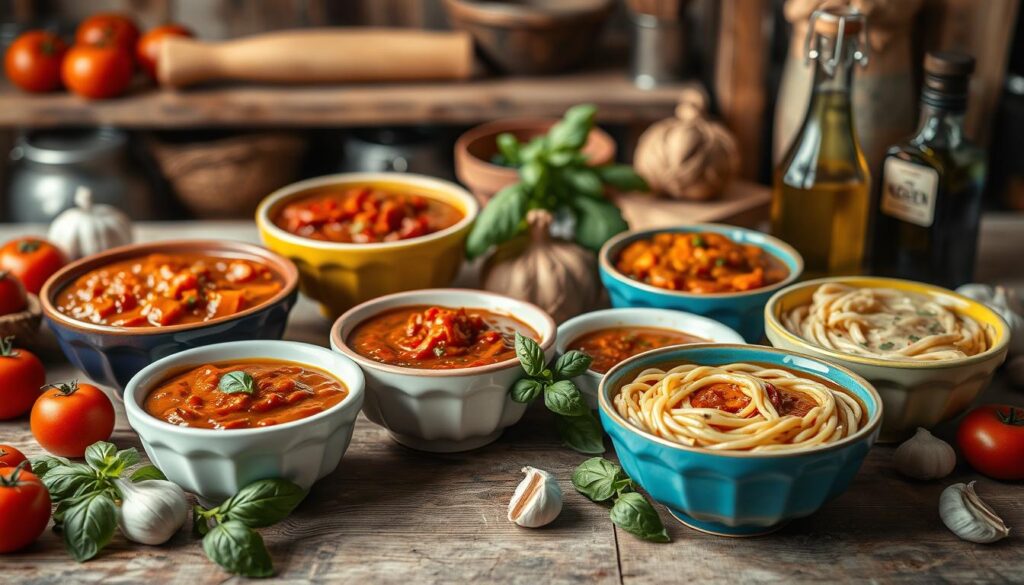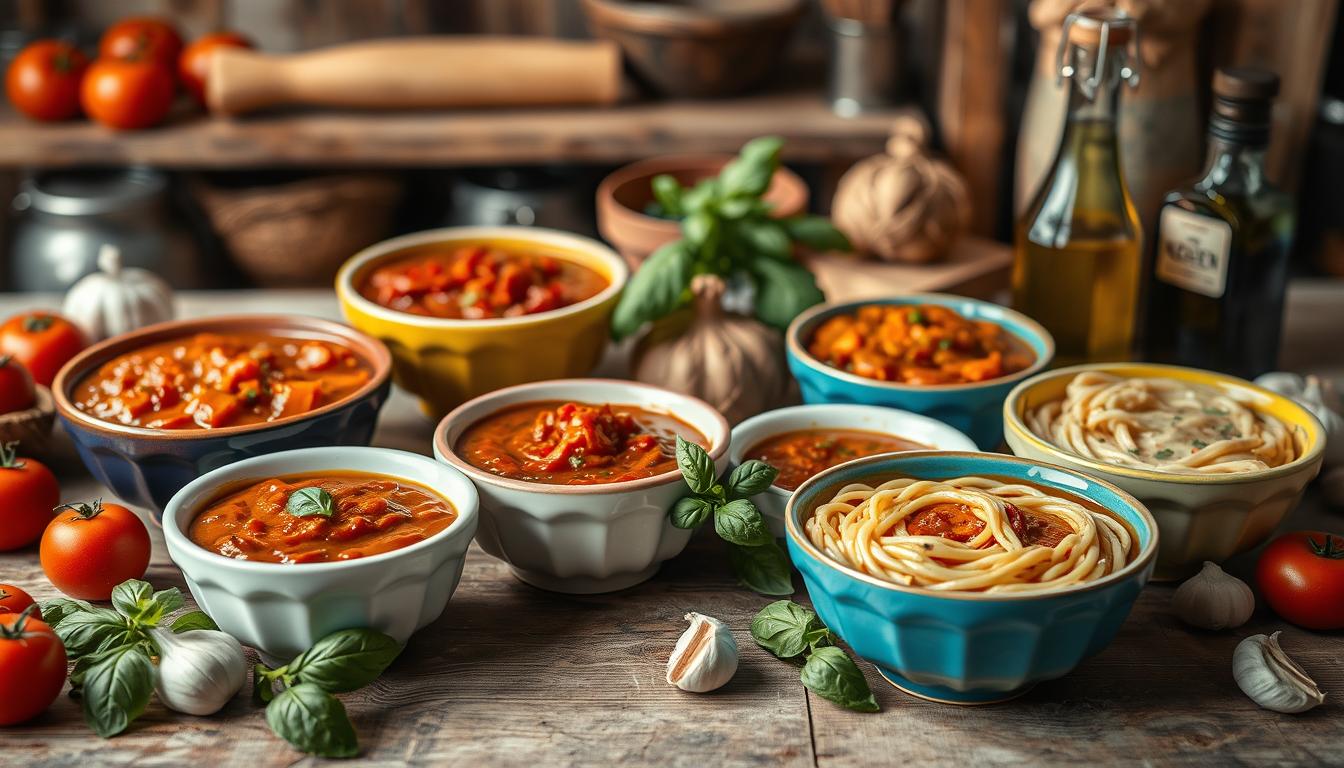
Every kitchen has a story, and mine started with the smell of tomato sauce and the sound of pasta stirring. Making perfect spaghetti is more than cooking—it’s an art passed down through generations. It can change how you cook, whether you’re new or experienced.
To make perfect spaghetti, you need more than boiling water and a package. It takes precision, passion, and knowing traditional cooking tips. These tips turn a simple dish into a memorable one. The key is choosing the right ingredients and mastering the techniques that make Italian food famous.
Key Takeaways
- Authentic Italian pasta requires high-quality, fresh ingredients
- Mastering dough preparation is crucial for perfect texture
- Understanding cooking techniques ensures ideal pasta consistency
- Sauce selection dramatically impacts overall dish quality
- Practice and patience are essential in pasta making
Essential Ingredients for Authentic Italian Pasta
Making authentic Italian spaghetti starts with top-notch ingredients. Your journey to perfect comfort food begins with knowing the key parts. These parts turn simple ingredients into a culinary masterpiece.
Selecting the Right Flour Type
The base of great pasta is the right flour. Tipo 00 flour is the top choice for Italian pasta. It makes your pasta silky and ensures it’s just right.
- Tipo 00 flour: Fine-ground wheat flour
- Protein content: Typically 12-13%
- Texture: Smooth and delicate
Understanding Egg Quality and Freshness
Eggs are key for rich, tasty pasta. Choose fresh, free-range eggs with bright yellow-orange yolks. They give the best taste and texture.
| Egg Characteristic | Ideal Specification |
|---|---|
| Freshness | Less than 1 week old |
| Yolk Color | Deep yellow-orange |
| Origin | Free-range chickens |
Salt and Water Considerations
The right salt and water make your pasta stand out. Use coarse sea salt and filtered water. They boost the flavors of your Italian recipe.
“The secret to perfect pasta is in the details – from flour to final seasoning.” – Italian Culinary Tradition
By picking each ingredient with care, you’ll make a memorable comfort food. It will capture the heart of traditional Italian cooking.
Perfect Spaghetti: Mastering the Basic Dough
Making the perfect spaghetti starts with the basic dough. Your pasta-making journey begins with knowing the key ingredients and techniques. These steps turn simple parts into a great culinary experience.
To make the ideal spaghetti dough, you’ll need:
- 2 cups of 00 or all-purpose flour (about 250 grams)
- 2 large eggs
- 3 egg yolks
- Pinch of salt
- Semolina flour for dusting
The kneading process is key for perfect spaghetti. Spend 4-5 minutes kneading until the dough is smooth and elastic. This makes your pasta perfect for homemade marinara sauce.
“Knead the pieces of dough together – with a bit of work and some love and attention they’ll all bind together to give you one big, smooth lump of dough!”
For successful pasta dough, let it rest. Let it sit for at least 30 minutes, but up to 4 hours. This makes the dough easier to roll and shape.
When rolling your dough, aim for a thickness of about 1/4-inch (6.35 mm). Then, thin it to about 1/16-inch (1.58 mm) for the best noodle consistency. Cut your pasta sheets into 12-14 inch lengths for easier handling.
Remember, practice makes perfect. Each time you make spaghetti dough, you’ll get better. You’ll learn more about this classic Italian staple.
Tools and Equipment for Pasta Making
Making the perfect spaghetti dinner is more than just skill. It also needs the right kitchen tools. Whether you’re new to cooking or have lots of experience, knowing your equipment can make a big difference.
Creating authentic spaghetti means choosing the right tools. These tools should fit your cooking style and kitchen. Both professional and home chefs have many options for making delicious pasta.
Manual vs. Machine Rolling Options
There are two main ways to roll pasta dough:
- Manual Rolling Pin: It’s budget-friendly and true to Italian tradition.
- Pasta Machine: It gives precise and consistent thickness.
“If you haven’t got a pasta machine it’s not the end of the world! All the mammas I met while travelling round Italy rolled pasta with their trusty rolling pins.”
Essential Kitchen Tools
Here’s what you need for pasta making:
- Large mixing bowls
- Measuring cups
- Sharp pasta cutting wheel
- Bench scraper
- Clean kitchen towels
Pasta Drying Equipment
Drying pasta right is key to keeping it quality. Here are some options:
- Pasta drying rack
- Clean kitchen dowels
- Pasta hanging lines
Most home cooks can make great spaghetti with basic tools. The secret is knowing your tools and practicing your skills.
Step-by-Step Pasta Rolling Technique
Creating perfect spaghetti needs careful rolling of the pasta dough. To start, pick the right surface and tools for rolling.

First, dust your work surface with Tipo 00 flour. This flour keeps your dough smooth and prevents it from sticking.
- Choose a clean, flat surface with ample space
- Keep extra flour nearby for dusting
- Select a pasta machine or rolling pin based on your preference
Begin with a pasta machine set to the widest setting. Take a dough piece the size of a large orange. Flatten it with your fingers. Then, feed it through the machine, making it thinner with each pass.
*Pro cooking tip: Handle the dough gently to prevent tearing and maintain a consistent texture.*
For hand rolling, apply steady pressure with your rolling pin. Turn the dough often to get even thickness. Aim for a thin, clear sheet for authentic spaghetti.
- Roll from the center outward
- Maintain consistent pressure
- Rotate dough frequently
- Aim for even, thin layers
Getting better at pasta rolling takes practice and patience. Each try will help you make perfect spaghetti at home.
Creating the Ideal Pasta Thickness
Making perfect spaghetti needs careful attention to its thickness. Getting the pasta just right is key for a true Italian dish. It should feel al dente, which is just right in texture.
Learning to make pasta the right thickness is a skill. It involves both using machines and rolling by hand. It takes practice and a focus on detail.
Machine Settings Guide for Perfect Pasta
Here’s how to use a pasta machine:
- Begin with the widest setting (usually setting 1)
- Lower the thickness with each roll
- Fold the pasta sheet in thirds for evenness
- Keep rolling through settings 1 to 6, getting thinner
Hand Rolling Techniques
If you don’t have a pasta machine, hand rolling is the way to go. It takes patience and skill:
- Use a long wooden rolling pin
- Roll on a lightly floured surface
- Roll from the center outwards, keeping it even
- Strive for a thin, even sheet
Achieving Consistent Results
For the best spaghetti, consistency is everything. Here are some tips:
- Work with small dough pieces (1/4 or 1/6 of the total)
- Dust with semolina to prevent sticking
- Roll evenly to avoid unevenness
- Let the dough rest for 30-60 minutes between rolls
“The secret to perfect pasta is patience and practice.” – Italian Pasta Master
By following these steps, you can make amazing spaghetti at home. Your pasta will be as good as what you find in restaurants.
Traditional Italian Sauce Pairings
Creating an authentic Italian recipe means knowing how to pair sauces. Your homemade marinara sauce can turn a simple spaghetti dinner into a masterpiece. Just pick the right sauce to go with it.

Classic Italian pasta sauces bring a variety of flavors and textures. They make your homemade spaghetti even better. Here are some traditional pairings to take your spaghetti dinner to the next level:
- Marinara Sauce: The quintessential tomato-based sauce perfect for classic spaghetti dishes
- Bolognese: A rich meat sauce that adds depth and complexity to your pasta
- Carbonara: A creamy sauce featuring eggs, cheese, and pancetta
- Pesto: A vibrant green sauce made with fresh basil, pine nuts, and olive oil
“In Italy, sauce is not just a topping, it’s a relationship with the pasta.” – Italian Culinary Tradition
When picking a sauce for your spaghetti, keep these tips in mind:
- Light, smooth sauces work best with long, thin pasta strands
- Chunky sauces pair well with pastas that can capture small pieces
- Creamy sauces complement ribbon-like pasta shapes
Your homemade marinara sauce will stand out when paired with the right pasta. Try different combinations to find your favorite authentic Italian recipe. It will make your spaghetti dinner unforgettable.
Cooking Methods and Timing
Mastering al dente pasta cooking needs precision and focus. Your success with spaghetti comes from knowing key cooking techniques. These techniques turn simple ingredients into a culinary work of art.
Water Temperature and Salt Ratio
Perfect spaghetti starts with the right water. Here’s what you need:
- 4 quarts of water for every 1 pound of pasta
- 1.5-3 tablespoons of salt for 4 quarts of water
- Bring water to a rolling boil before adding pasta
Al Dente Testing Techniques
Getting al dente pasta right takes timing and taste. Here are some tips:
- Start testing pasta 2 minutes before the recommended time
- Check pasta every 20-30 seconds
- Taste to make sure it’s just right
“The perfect pasta should have a slight resistance when bitten” – Italian Cooking Tradition
Sauce Integration Tips
Adding sauce is the final step. Save ½ to 1 cup of pasta water. It helps with sauce consistency and flavor.
| Pasta Type | Cooking Time | Water Ratio |
|---|---|---|
| Dried Spaghetti | 8-10 minutes | 4 quarts per pound |
| Fresh Pasta | 1-3 minutes | 4 quarts per pound |
By using these methods, you’ll make al dente spaghetti that impresses every time.
Common Mistakes to Avoid
Making perfect spaghetti at home needs precision and care. Many home cooks face challenges that can ruin their pasta-making. Knowing these common tips will help you make delicious al dente pasta every time.
- Water Quantity Matters: Always use at least 4 quarts of water per 1 pound of pasta to prevent starchy, clumpy results.
- Salt Wisely: Use ⅓ cup of kosher salt for 5 quarts of water to enhance flavor effectively.
- Avoid Adding Oil: Olive oil in boiling water can make pasta too slick, preventing sauce from adhering properly.
Cooking perfect spaghetti requires mastering key techniques. One important tip is understanding the role of water temperature and pasta texture.
“Al dente is not just a technique, it’s an art of balancing texture and flavor.” – Italian Culinary Experts
| Common Mistake | Consequence | Solution |
|---|---|---|
| Overcooking Pasta | Mushy texture | Check doneness every 30-60 seconds |
| Using Cold Water | Increased starch release | Always start with boiling water |
| Draining Completely | Dry pasta | Reserve some cooking water for sauce |
Remember, making perfect spaghetti is about practice and understanding these techniques. Taste testing is your best tool for determining the ideal al dente texture.
Conclusion
Making the ultimate spaghetti dinner is more than a recipe. It’s a journey that turns your kitchen into a true Italian experience. With your new skills, home cooking becomes extraordinary, making every meal a comfort food celebration.
Remember, precision is key when cooking spaghetti. Italians focus on portion control, aiming for 3-4 oz of pasta per person. By mastering techniques like salt measurement and cooking times, your pasta will stand out.
Practice makes perfect when it comes to spaghetti. As you try new techniques and ingredients, you’ll get better. Whether it’s a classic carbonara or something new, your homemade spaghetti will be a canvas for creativity.
Enjoy making handmade pasta—it’s about more than just food. It’s about creating special moments. With each batch, you’ll grow more confident and closer to making a dish as good as a restaurant’s.
FAQ
What type of flour is best for making authentic Italian spaghetti?
For real Italian spaghetti, use Tipo 00 flour. It’s finely ground and gives pasta the right texture and stretch. This flour makes your pasta smooth and delicate, just like in Italy.
How do I know when spaghetti is perfectly cooked (al dente)?
Cook your pasta until it’s tender but still firm. Cook 1-2 minutes less than the package says. It should feel slightly hard when you bite into it, but not crunchy.
Can I make spaghetti without a pasta machine?
Yes, you can make spaghetti by hand. Use a rolling pin and a sharp knife. It’s a bit harder, but you can roll the dough thin and cut it into strands.
What’s the best sauce to pair with homemade spaghetti?
Marinara sauce is a great choice for homemade spaghetti. Try Bolognese, carbonara, or olive oil and garlic sauce for an authentic taste. Pick a sauce that goes well with your fresh pasta.
How long can I store homemade spaghetti?
Store fresh spaghetti in the fridge for 2-3 days. Freeze it for up to 4 weeks. Keep it floured and in an airtight container to prevent sticking.
What common mistakes should I avoid when making spaghetti?
Avoid overworking the dough and using the wrong flour ratio. Don’t roll it too thick and watch the cooking time. Let the dough rest, measure carefully, and roll it thin for perfect pasta.
Do I need special equipment to make homemade spaghetti?
You don’t need a pasta machine to make spaghetti. Basic tools like a rolling pin and sharp knife are enough. The key is patience and practice.
How do I prevent my homemade pasta from sticking together?
Dust your pasta with flour before and after cutting. Use salted water and stir while cooking. Store it with flour and parchment paper to keep it separate.

